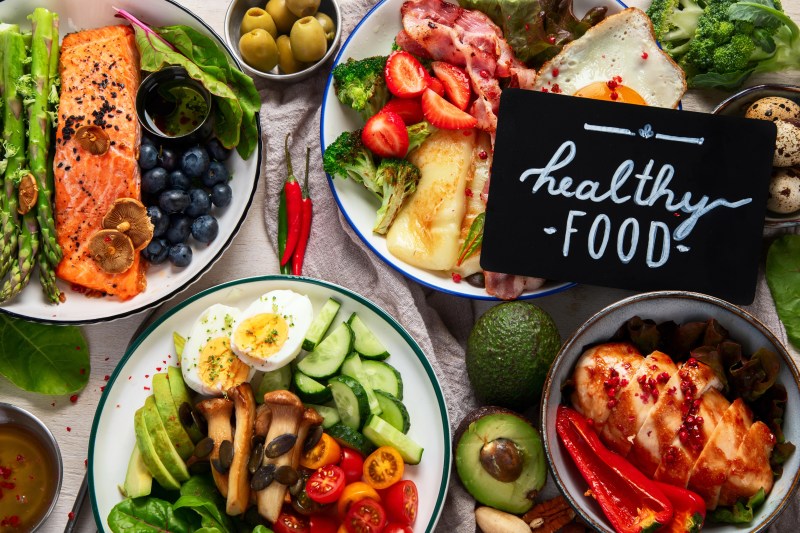Keto cycling promises flexibility within the ketogenic diet, but does it help you reach your goals, or could it hinder your progress?
Let’s examine the pros and cons of keto cycling to determine if it’s the right choice for you and learn how to maximize the health benefits of a low-carb diet.
Keto basics
The standard keto diet is a low-carbohydrate, high-fat eating plan that typically limits carbohydrate intake to 50 grams or less per day while emphasizing healthy fats and moderate amounts of protein.
The primary goal of this diet is to transition the body from using glucose as a fuel source to burning fat to generate energy in the form of ketones.
This highly efficient metabolic process, referred to as ketosis, has been linked to several potential benefits, including weight loss, improved mental clarity, reduced inflammation, and more stable energy levels.
“The most effective way to follow a ketogenic diet is by focusing on nutrient-dense foods, avoiding inflammatory ingredients, and steering clear of processed foods,” explains Dr. Berg.
This method is known as Healthy Keto®, which, in addition to low-carb intake, prioritizes a balanced diet of nutritious and healthy foods to promote optimal nutrient intake and overall metabolic health.
Healthy Keto focuses on quality foods such as pasture-raised meat and eggs, grass-fed dairy, and healthy fats, including avocado, olive oil, and coconut oil. It also includes wild-caught fish, organic, non-genetically modified (GMO) vegetables, nuts, and seeds.
These whole foods promote fat-burning while providing essential nutrients without the harmful additives or inflammatory compounds found in most processed foods.
Watch the video below to learn if carb cycling is healthy while following a ketogenic diet.
What is keto cycling?
Keto cycling, also known as the cyclical ketogenic diet, involves alternating between strict keto diet days and days with higher carbohydrate intake.
Cyclic keto isn’t strictly defined, and cycle lengths can vary widely.
Some people opt for shorter cycles, adding higher-carb days within a single week, much like carb cycling. Others choose longer cycles, staying in ketosis for several weeks to months before briefly reintroducing carbs and then returning to keto.
Supporters of the cyclical keto diet believe it helps reduce the risk of nutrient deficiencies, alleviates keto flu symptoms, and makes it easier to stick to a low-carb diet long-term.
However, these benefits are largely speculative and often overlook how they may be linked to the consumption of processed, inflammatory foods typically associated with a dirty keto diet.
Unfortunately, standard keto often neglects to highlight the significance of whole, unprocessed foods, leading many people to inadvertently adopt a dirty keto approach.
This leads to overreliance on convenience foods marketed as keto-friendly, which often contain hidden sugars and pro-inflammatory omega-6 fatty acids, which can negatively impact health.
As a result, many cases of keto-related nutrient deficiencies and keto flu symptoms are due to a lack of nutritious whole foods, underscoring the importance of balanced nutrition and a thoughtful approach to keto.

Downsides of keto cycling
While proponents claim that keto cycling makes the ketogenic diet more manageable, it’s essential to consider the potential downsides of this approach.
Cycling between high- and low-carb days can prevent the body from fully adapting to ketosis. Keto fat adaptation involves developing the cellular processes needed to burn fat efficiently, and it can take 4 to 12 weeks to become fully fat-adapted.
Furthermore, frequent carb intake during keto cycling may increase oxidative stress and inflammation.
Research published in Sports highlights, “Compared to glucose oxidation, fat-centered oxidation involves producing less reactive oxygen species during the process. Excessive free radicals and chronic inflammation are harmful to mitochondria, muscular cells, and whole-body health.”1
Inflammation can disrupt insulin regulation, leading to hormonal imbalances and an increased risk of insulin resistance.
As a result, regular keto cycling can trigger blood sugar fluctuations, heightened cravings, and energy crashes, which can ultimately undermine the effectiveness of the diet and make it harder to maintain long-term success.

Should you do keto cycling?
While keto cycling may seem like an easier approach, it often undermines the health benefits many seek from a ketogenic diet. If your goal is sustained weight loss and improved overall health, consistently following Healthy Keto is much more effective.
Keto cycling can prevent the body from fully adapting to ketosis, which relies on a steady, high-fat diet and minimal carb intake to help the liver convert fatty acids into ketones efficiently.
Moreover, research published in Frontiers in Nutrition suggests that a low-carbohydrate, high-fat diet may protect against metabolic conditions such as non-alcoholic fatty liver disease, which can be exacerbated by frequent carb intake.2
Rather than relying on keto cycling, a more effective approach to the ketogenic diet is to focus on meal preparation to create balanced, nutrient-rich meals.
Additionally, by avoiding inflammatory and addictive ultra-processed foods, which are high in sugar, seed oils, and artificial ingredients, you can help prevent food cravings, feel more satisfied after eating, and reduce common side effects such as keto flu.

Key takeaways
Keto cycling might seem like an easy way to add flexibility to your keto regimen, but the potential disruptions to ketosis and metabolic health outweigh any perceived benefits.
For a more sustainable approach, it’s recommended to follow a Healthy Keto® diet, which emphasizes balanced nutrient intake while avoiding inflammatory foods.
By focusing on a diet rich in whole, nutrient-dense foods, you can reduce cravings, minimize keto flu symptoms, and make long-term adherence to keto more manageable and satisfying.
FAQ
1. Is cyclical keto effective?
While cyclical keto offers flexibility, it disrupts steady ketosis, which is crucial for full-fat adaptation. This disruption can lead to increased inflammation and impaired insulin regulation, potentially hindering weight loss.
2. What are the downsides of keto cycling?
Frequent carb intake disrupts keto-adaptation by causing the body to switch between using glucose and ketones, which delays fat burning, contributes to inflammation, and negatively impacts metabolic health.
3. Should you have a cheat day on keto?
Cheat days interrupt ketosis and can lead to fluctuating insulin levels and weight gain. Instead, keep keto-friendly alternatives on hand, such as fat bombs, to satisfy cravings without breaking ketosis.
4. What is the difference between keto and carb cycling?
Keto involves sustained low-carb intake to maintain ketosis, a metabolic state in which the liver converts fatty acids into ketones that serve as a highly efficient alternative fuel source.
In contrast, carb cycling involves alternating between low-carb days, typically around 100 grams, and higher-carb days, allowing for strategic carbohydrate intake often utilized by endurance athletes and bodybuilders.
5. Is keto cycling good for weight loss?
Keto cycling can disrupt ketosis, prevent fat adaptation, and potentially hinder your ability to lose weight.
A steady low-carbohydrate diet, such as Healthy Keto®, which focuses on nutrient-dense foods, promotes consistent fat-burning and metabolic stability, making it an effective approach for weight management.
6. Is keto cycling healthy?
No, keto cycling isn’t healthy as it disrupts ketosis and can impair insulin regulation, which can increase the risk of insulin resistance, weight gain, and other metabolic imbalances.
Sources
- https://www.ncbi.nlm.nih.gov/pmc/articles/PMC6410243/ ?
- https://www.ncbi.nlm.nih.gov/pmc/articles/PMC10987868/ ?







